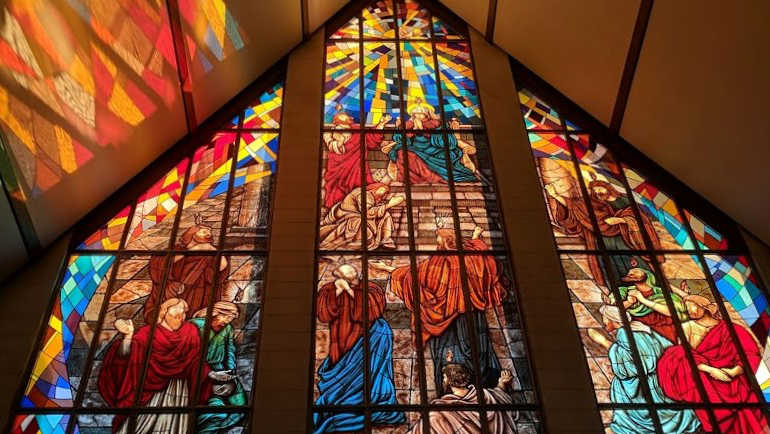
In today’s Gospel we hear Jesus’ first words after his Resurrection – “Peace be with you.” Then He shows them his wounds, offers his peace again, sends them on a mission. He tells them to receive his Holy Spirit and to believe in Him. It’s the same message to us today. It is important to take his Easter gift of Peace seriously – to be at peace within ourselves, within our families, and with one another—to carry on our mission as witnesses of the Resurrection and to believe in Him.
Jesus came and stood among them, in the midst of their fear, their deflated hopes, their crucified dreams, their regrets and their sorrows and he said, “Peace be with you”. In Aramaic, the first language of Jesus, it was one word: “Shalom!” Still spoken across Israel every day, and in Jewish homes throughout the world, Jesus said it to them, and he says it to you: “Shalom. Peace be with you” and God’s Shalom is not just an absence of conflict or an end to fear or worry. It is so much more than that. God’s shalom for you and me is the fullness of his peace within us, His well-being in our hearts and minds, a peace that nothing else and no-one else can give.
I can imagine what they may have been thinking, and I guess there were some massive ‘buts’ in the room!
But it wasn’t meant to be like this. We followed him around and listened to his teaching for three years and now he’s dead. Was it all a waste of time?
But Mary Magdalene says she has seen and encountered Jesus.
But what happens now? What do we do? To whom do we turn? They killed Jesus! Will we be next? But I remember. He said our grief will be turned to joy!
What Big Buts are you carrying right now? What is looming large and stopping you from moving forward with Jesus? Can you name those ‘buts’ before God?
Whatever big but or little but is looming Jesus says to you and me, “Shalom. Peace be with you.”
But what does believing in Jesus Christ mean? Isn’t that the real question? Lots of churches, real and so-called, profess some kind of belief in Jesus; and even Muslims call Jesus a prophet.
When we proclaim that we believe in Jesus, we acknowledge that Jesus, and Jesus alone, is the “Lamb of God, who takes away the sins of the world”. We are a believing church in a doubting world, and that’s what we believe.
St. Thomas struggled with belief, with the “in between” of faith.
We live in between. If, as the author of Hebrews writes, “Faith is being sure of what we hope for and certain of what we do not see” (Heb. 11:1), then we are in between “what we hope for”, and not seeing it. That is the posture of faith—the posture of “in between.”
– – – Continue here from the bulletin – – –
The Bible isn’t a record of perfect people. Jesus alone is perfect.
Doubt isn’t always bad. First, doubt isn’t the same thing as unbelief. Unbelief is the willful rejection of faith. Doubt is uncertainty. And uncertainty does not have to lead away from faith.
Rev. Dr. Martin Luther King Jr. once said: “Faith is taking the first step even when you don’t see the whole staircase.” That’s what leaders and visionaries do. They believe in something bigger than themselves, and they begin to act as if it is so.
Blessed are those who face contradictions with God given confidence.
Blessed are those who hear the facts but trust the truth.
Blessed are those who have not seen but yet believe.
Thomas certainly had doubts. Jesus invited Thomas to put his fingers into his hands and side to satisfy his doubts. Thomas did not see the need to move a muscle other than his tongue and he utters one of the most beautiful, awesome phrases in the Gospel – “My Lord and My God”.
Doubt can lead us to faith. When we have doubts, we can use them like stepping-stones.
What are our doubts that can become stepping-stones?
–Dcn. Terry Murphy

